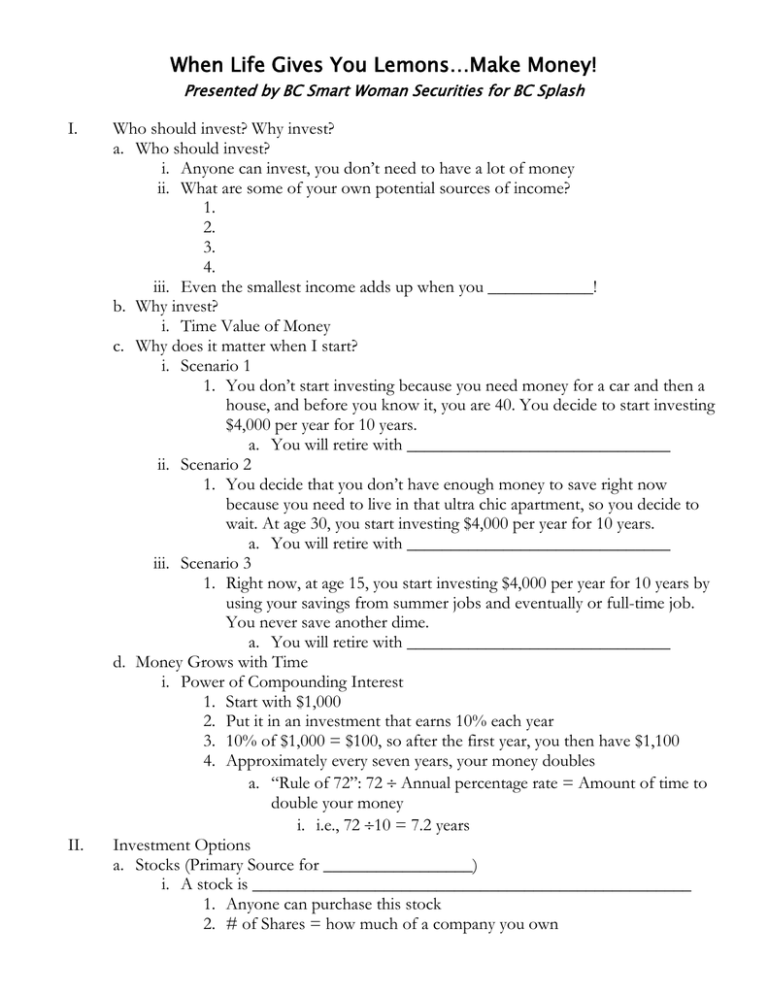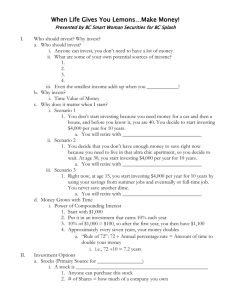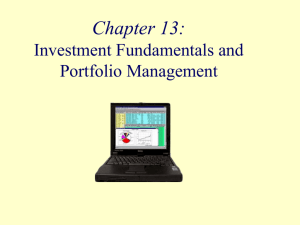When Life Gives You Lemons…Make Money!
advertisement

When Life Gives You Lemons…Make Money! Presented by BC Smart Woman Securities for BC Splash I. II. Who should invest? Why invest? a. Who should invest? i. Anyone can invest, you don’t need to have a lot of money ii. What are some of your own potential sources of income? 1. 2. 3. 4. iii. Even the smallest income adds up when you ____________! b. Why invest? i. Time Value of Money c. Why does it matter when I start? i. Scenario 1 1. You don’t start investing because you need money for a car and then a house, and before you know it, you are 40. You decide to start investing $4,000 per year for 10 years. a. You will retire with ______________________________ ii. Scenario 2 1. You decide that you don’t have enough money to save right now because you need to live in that ultra chic apartment, so you decide to wait. At age 30, you start investing $4,000 per year for 10 years. a. You will retire with ______________________________ iii. Scenario 3 1. Right now, at age 15, you start investing $4,000 per year for 10 years by using your savings from summer jobs and eventually or full-time job. You never save another dime. a. You will retire with ______________________________ d. Money Grows with Time i. Power of Compounding Interest 1. Start with $1,000 2. Put it in an investment that earns 10% each year 3. 10% of $1,000 = $100, so after the first year, you then have $1,100 4. Approximately every seven years, your money doubles a. “Rule of 72”: 72 Annual percentage rate = Amount of time to double your money i. i.e., 72 10 = 7.2 years Investment Options a. Stocks (Primary Source for _________________) i. A stock is __________________________________________________ 1. Anyone can purchase this stock 2. # of Shares = how much of a company you own III. ii. As the company’s business grows, the per share value of the stock grows to reflect this 1. Many companies also pay back dividends to shareholders (for example, a company may pay out $1 per share each year) iii. Your investment return = ___________________ (money the company pays out to share holders) + ________________(rising value of shares also called capital gains) b. Bonds (Primary Source for __________________) i. A bond is an ________________ 1. You are loaning money to someone (Federal Government, Municipal Authorities, or Corporations) ii. You expect the initial loan amount will be returned to you at a stated time in the future with periodic interest payments. 1. This is a reason why bonds are also referred to as ______________________________ 2. You also receive additional regular “payments” for use of your money, often called “coupons” iii. Types of bonds (taxable fixed income) 1. Bank CDs = safety and insurance 2. U.S. Treasuries = safety 3. Corporate bonds = high/medium quality 4. High yield bonds = lower quality/high volatility (“junk bonds”) 5. Tax-exempt = Municipal bonds (federal, state, local) c. Cash (Primary Source for Stability & Liquidity) i. Also known as __________________________ accounts 1. Checking/Savings Accounts with interest 2. Bank Money Market Funds 3. Mutual Fund Money Market Funds a. Taxable b. Tax-exempt 4. Short-Term Bonds (less than one year) a. Treasury Bills ii. Low yield/return… but you know your money will be there when you need it So what should you invest in? a. Determining Your Financial Goals i. Now that we know some of the main categories of investments, how can you decide what to invest in? ii. Step 1: Set your financial goals 1. In order to set your goals, you need to: a. Determine a ____________________________________ (Are you saving to buy a car, a house, or retirement?) b. Determine your ___________________________________ (What stage in your life are you? How much money do you need to live on? How much risk can you tolerate?) c. Understand your priorities (What goals are the most important to you?) d. Quantify your priorities (How much money are you planning to save and invest and how much do you wish to have? Do these align?) iii. Step 2: Determine your __________________________________ b. Understanding Risk and Returns i. These are two important components when judging investments 1. The earlier examples about the time value of money were based on earning a 10% return every year, but 10% return a year is not always possible ii. Not all investments have the same risk; thus, not all investments yield the same return 1. For example, Treasury Bonds (issued by the US Treasury) are considered low risk, and therefore offer a lower return iii. Higher risk often leads to ____________________________ 1. You must be compensated for taking on higher risk investments whose growth is harder to predict (more volatile) than lower risk investments iv. Returns are relative to the market 1. If your return is 10% a year, but the market return is 15% a year, then you are doing worse than the market 2. Other factors, such as inflation, must be considered as well. If inflation is 10% and your investment return is 10%, your “real” return is 0% c. Risk Tolerance Spectrum i. Small Company Stocks ii. International Stocks iii. Large Company Stocks iv. Corporate Bonds v. Government Bonds vi. Cash Equivalents IV. Bottom line: Make saving a priority in your financial life, then help your savings grow by investing! Let’s Review 1) You should have at least $10,000 in savings before you start investing. a. True b. False 2) When you buy stock in McDonald’s Corporation (MCD): a. You have leant money to the company b. You are eligible for a free Big Mac every time you eat at McDonald’s c. Own a small part of the company. d. McDonald’s will return your original investment to you plus interest after one year. 3) In general, investments that are riskier tend to provide higher returns over time than investments with less risk. a. True b. False 4) What type of bond is the safest? a. Municipal Bond b. Corporate Bond c. High Yield “Junk” Bond d. U.S. Treasury Bond 5) When you are young, it is okay to have most of your retirement savings invested in risky assets like stocks. a. True b. False 6) Most successful investors like Warren Buffett a. owe their success to luck or pure chance. b. do a lot of practical research before making any investment decision c. use impossibly complicated mathematical formulas to make investment decisions d. are born with a super-human stock-picking gene 7) A $100 bill that you stash under your mattress today will be worth much more when you find it there in twenty years. a. True b. False Recommended Reading PERSONAL FINANCE: Suze Orman: The Courage to Be Rich The 9 Steps to Financial Freedom Stephen Covey: The 7 Habits of Highly Effective People Napoleon Hill: Think and Grow Rich Robert T. Kiyosaki: Rich Dad, Poor Dad The Cashflow Quadrant Thomas J. Stanley: The Millionaire Next Door The Millionaire Mind Millionaire Women Next Door Talane Miedaner: Coach Yourself to Success INVESTING: Joel Greenblatt: The Little Book that Beats the Market (very short) You Can Be a Stock Market Genius David and Tom Gardner: The Motley Fool Investing Guide For Teens Peter Bernstein: Against The Gods: The Remarkable Story of Risk Nassim Nicholas Taleb: Fooled by Randomness BUSINESS/INVESTORS: Roger Lowenstein: Buffett: The Making of An American Capitalist When Genius Failed: The Rise and Fall of Long Term Capital Management John Train: Money Masters of Our Time Lois Peltz: The New Investment Superstars Ben Mezrich: Bringing Down the House: The Inside Story of Six MIT Students That Took Vegas for Millions Ugly Americans: The True Story of the Ivy League Cowboys Who Raided the Asian Markets for Millions FINANCIAL PUBLICATIONS: Janet Hanson: More Than 85 Broads ONLINE RESOURCES: http://www.mymoney.gov http://www.fool.com http://www.investopedia.com http://www.finance.yahoo.com The Wall Street Journal The Economist Financial Times Barron’s If you have any further questions please do not hesitate to e-mail us at: bostoncollegesws@gmail.com For more information about SWS, visit our website: www.smartwomansecurities.com








